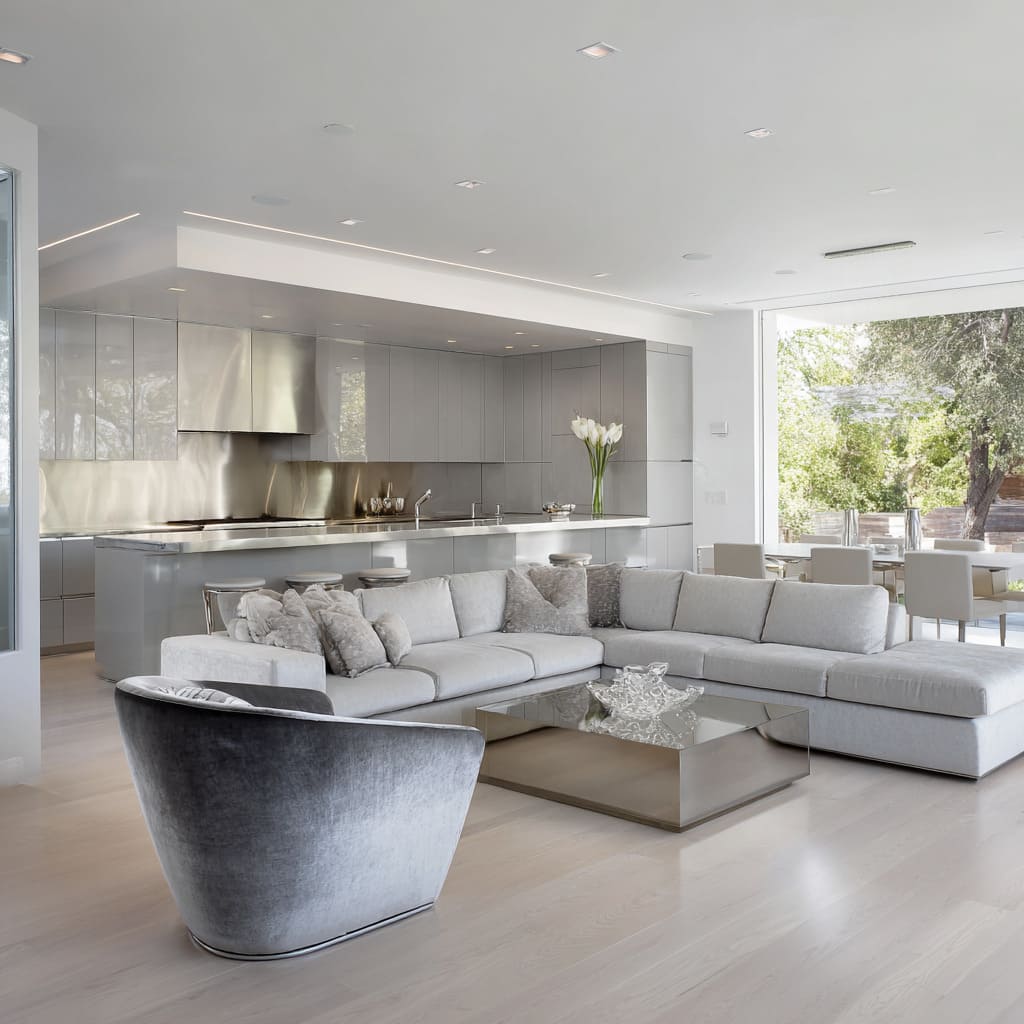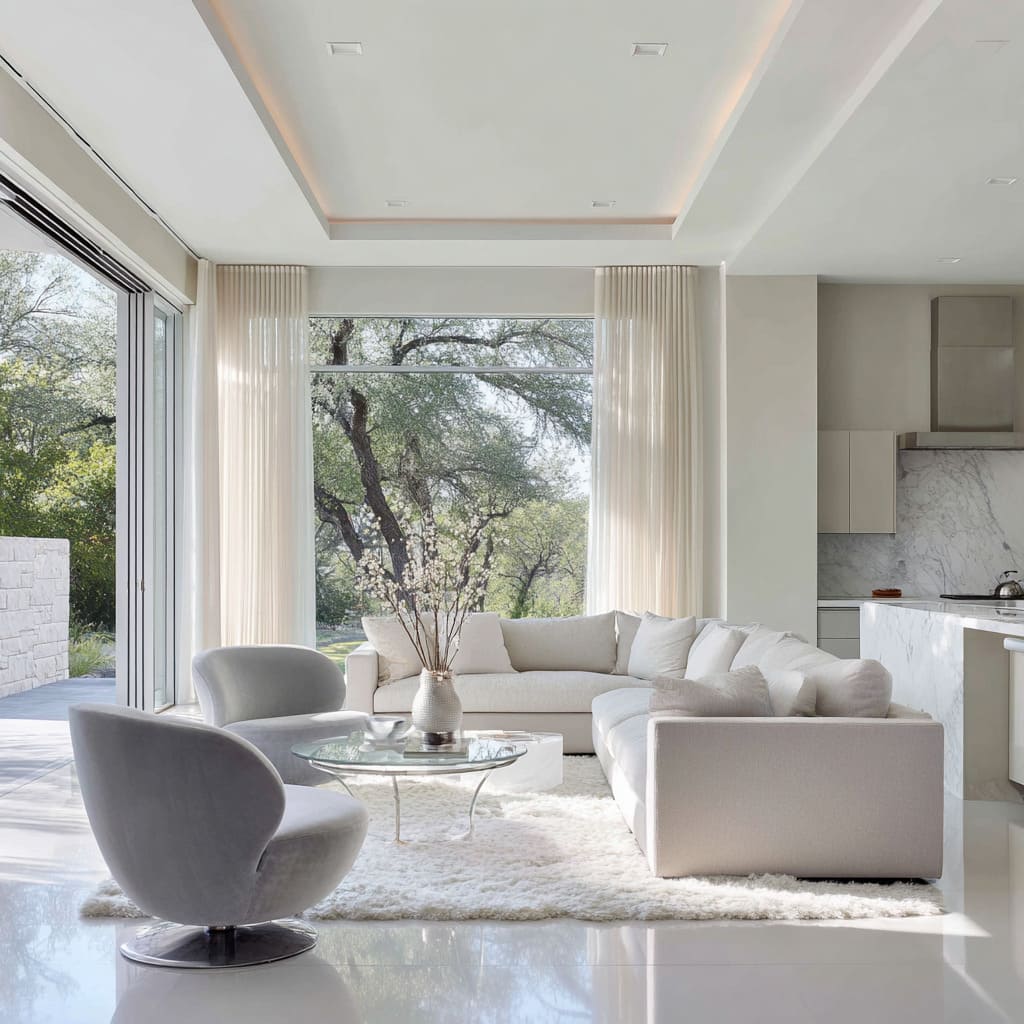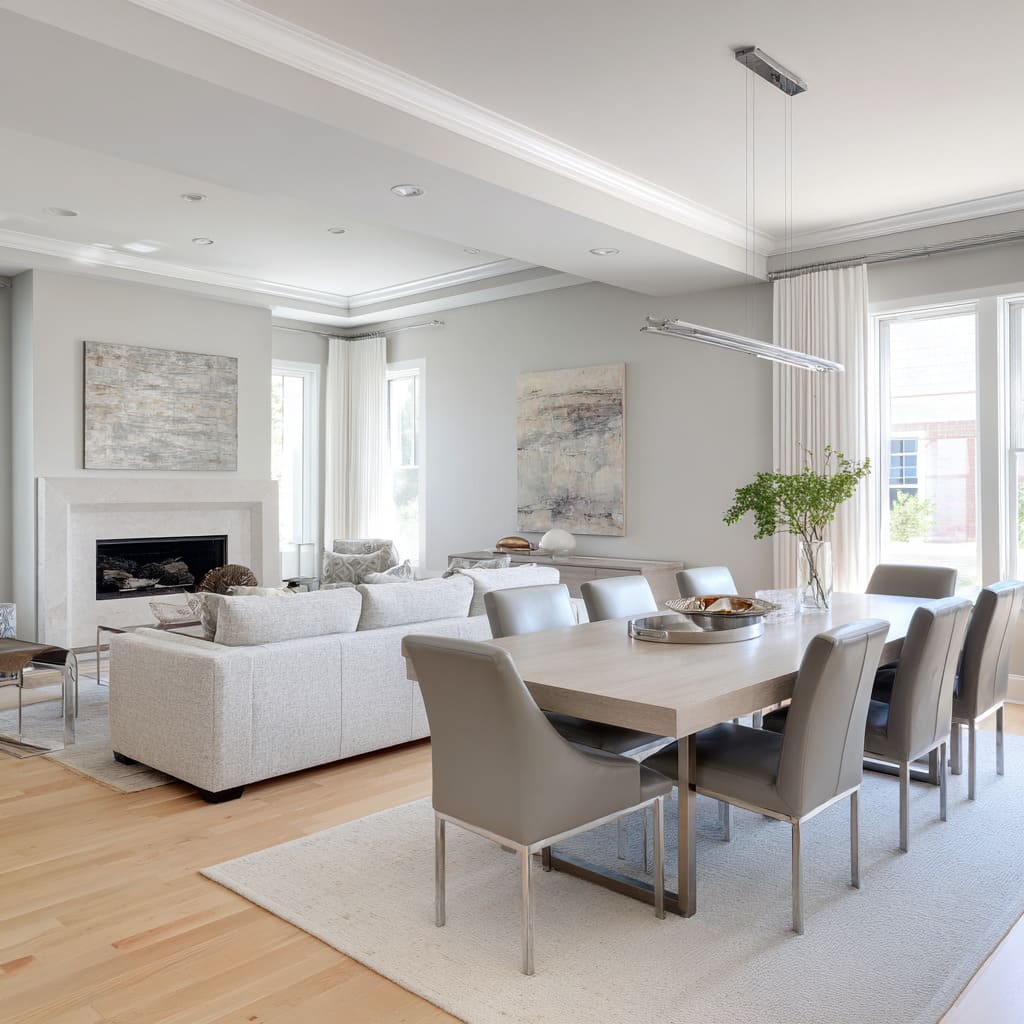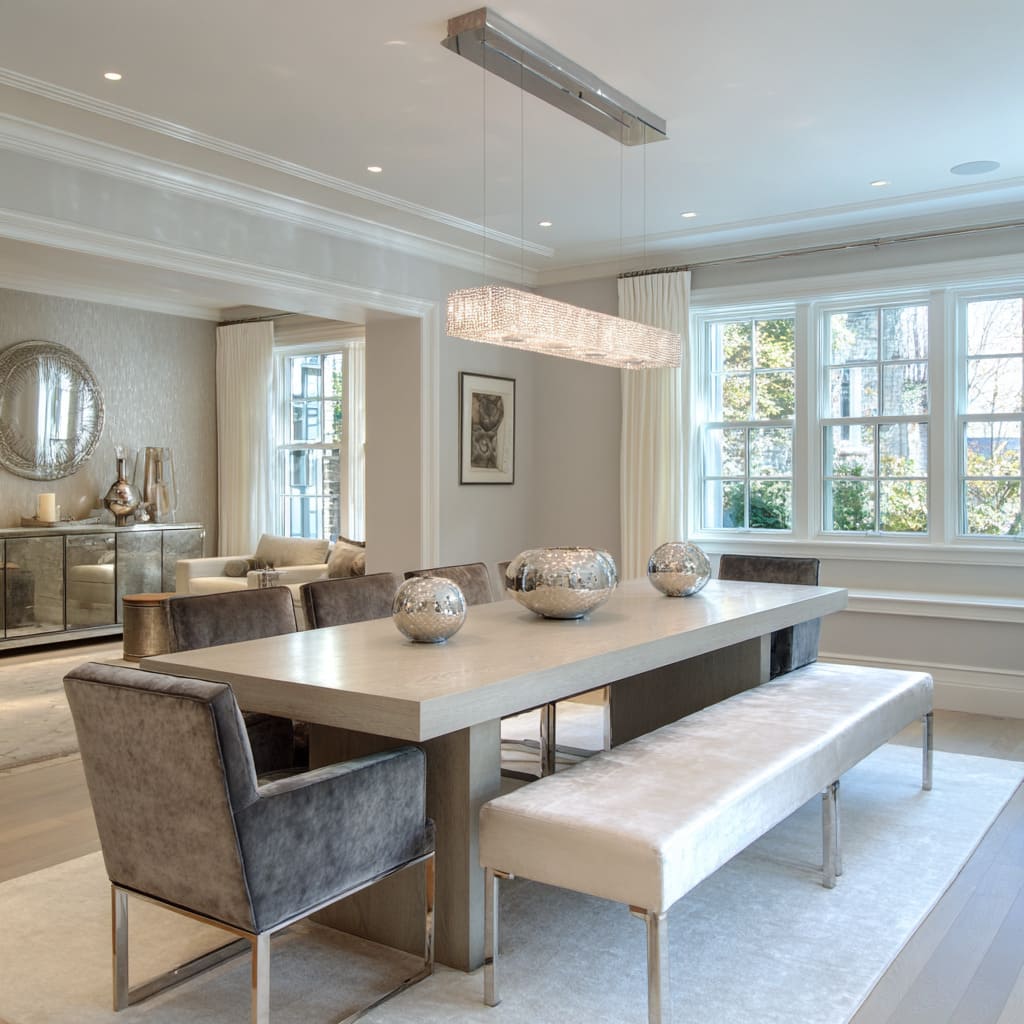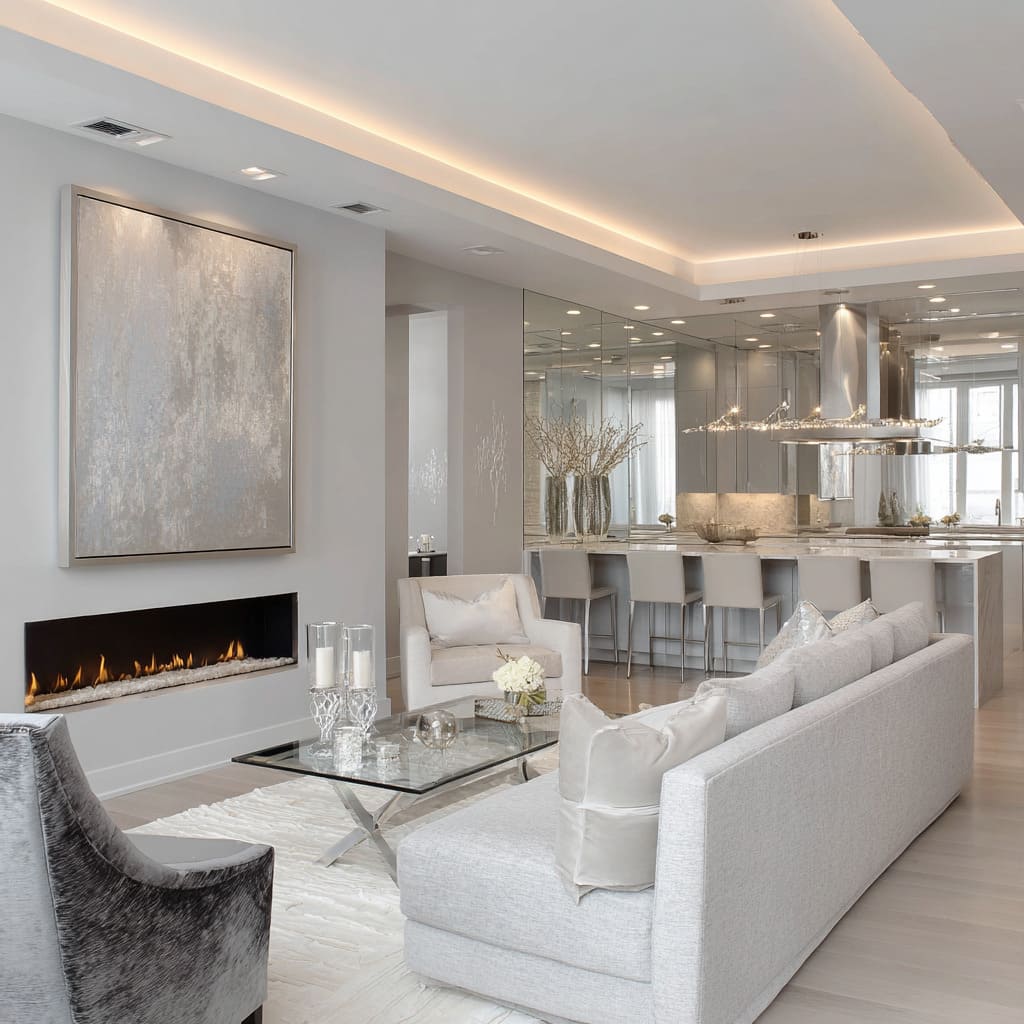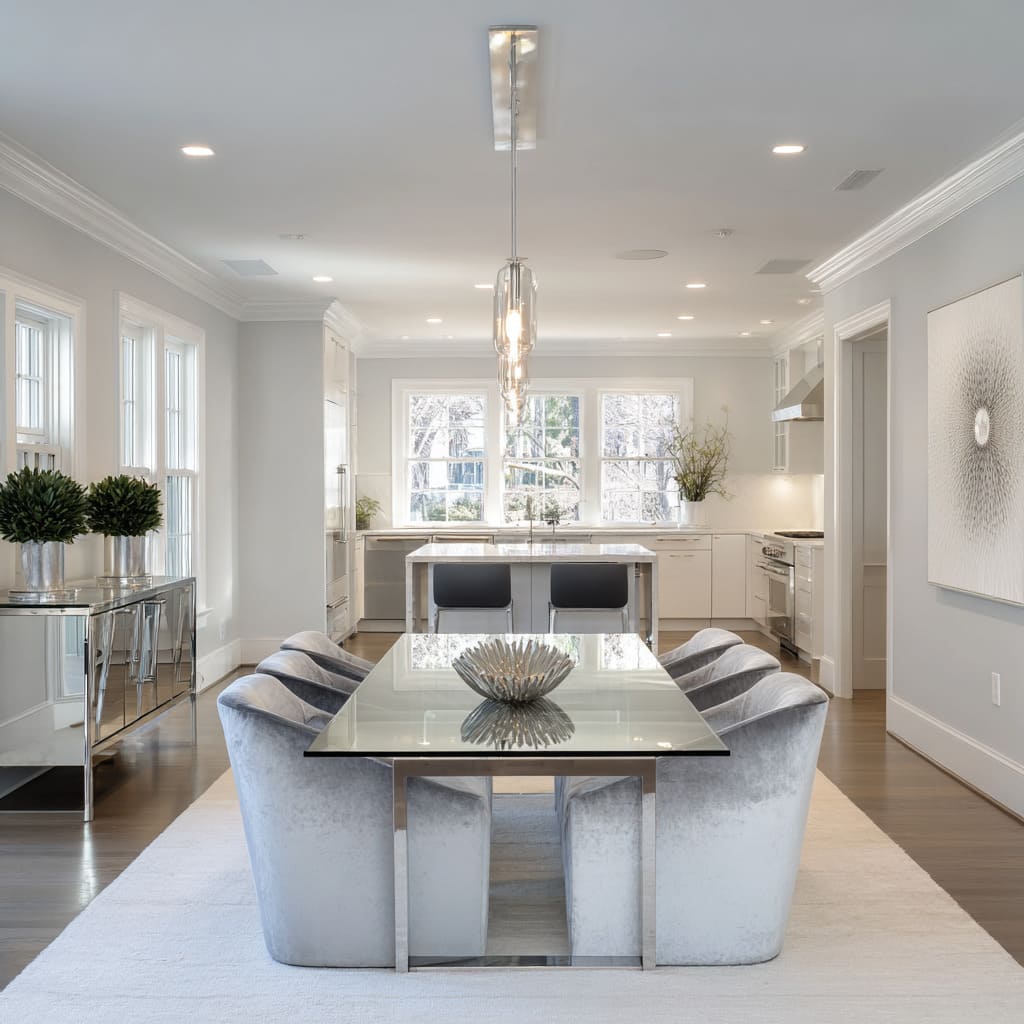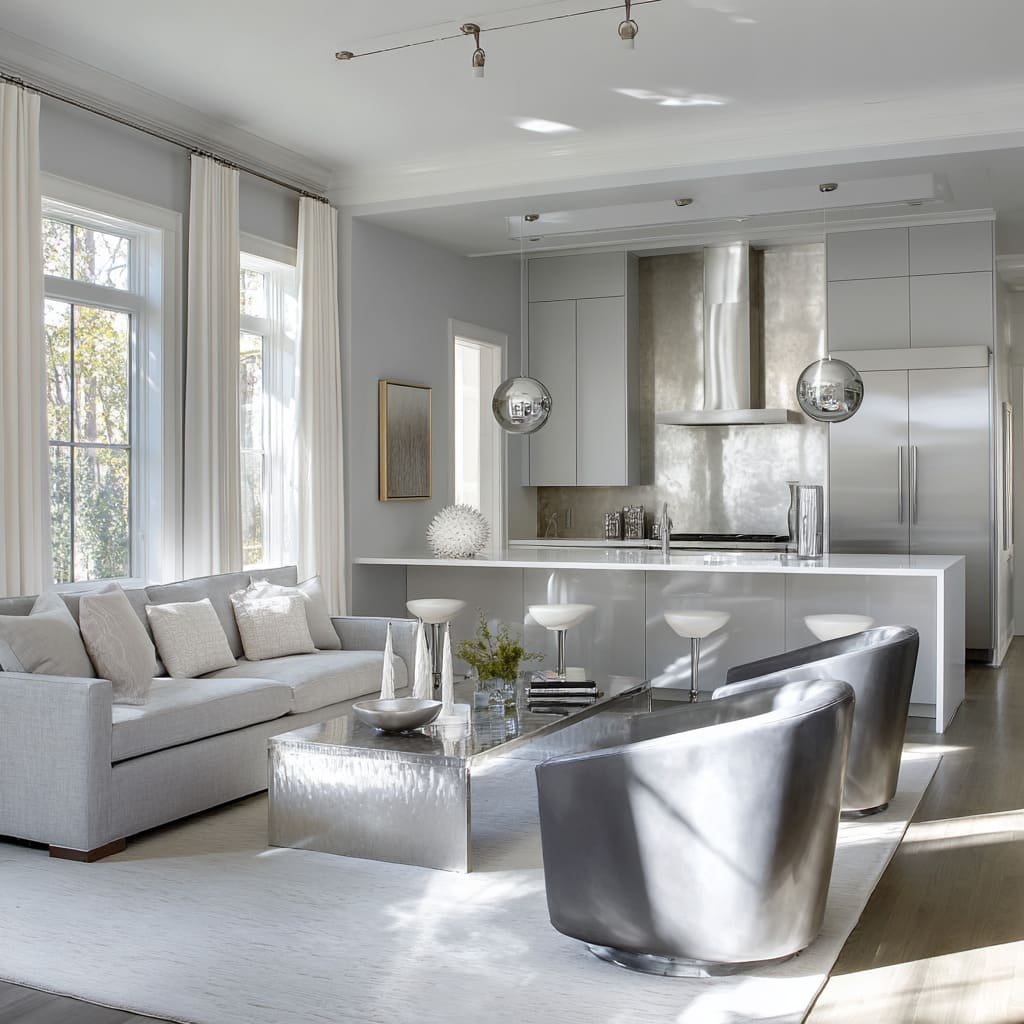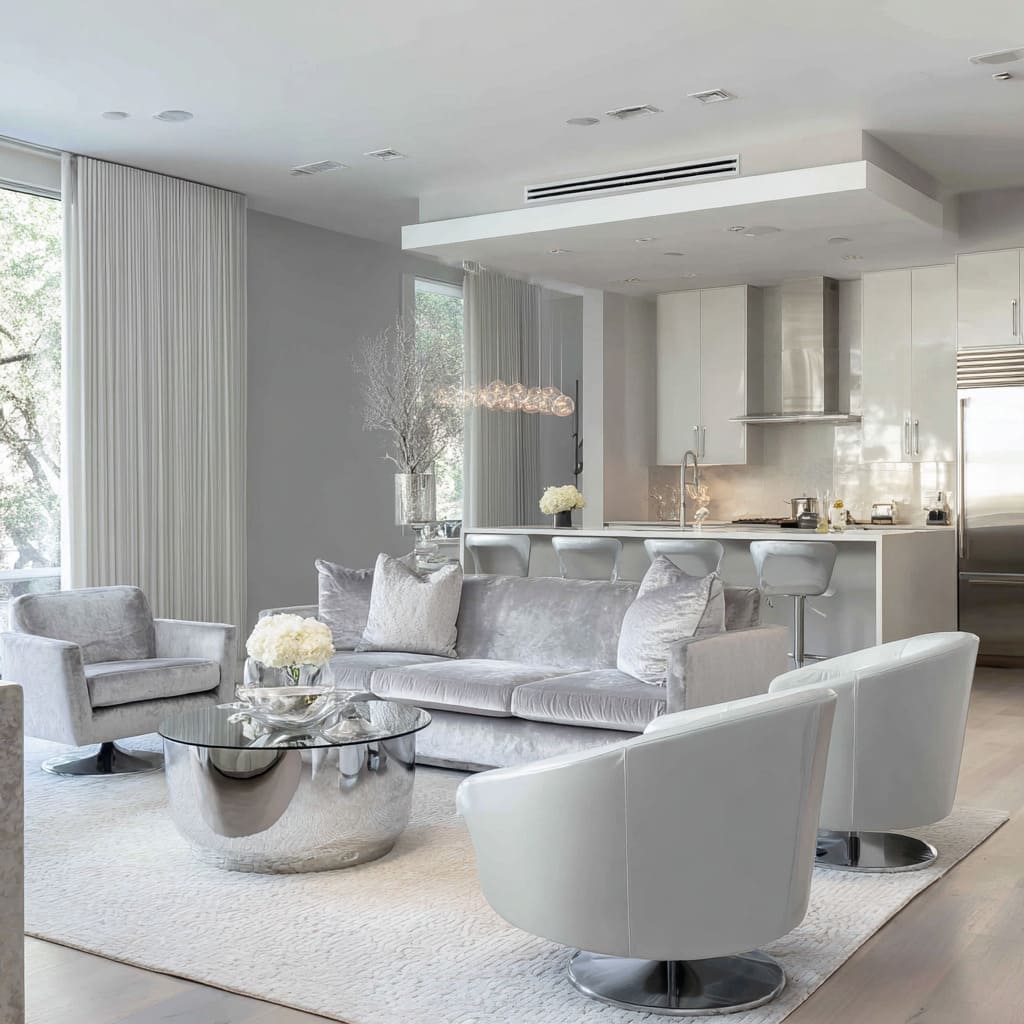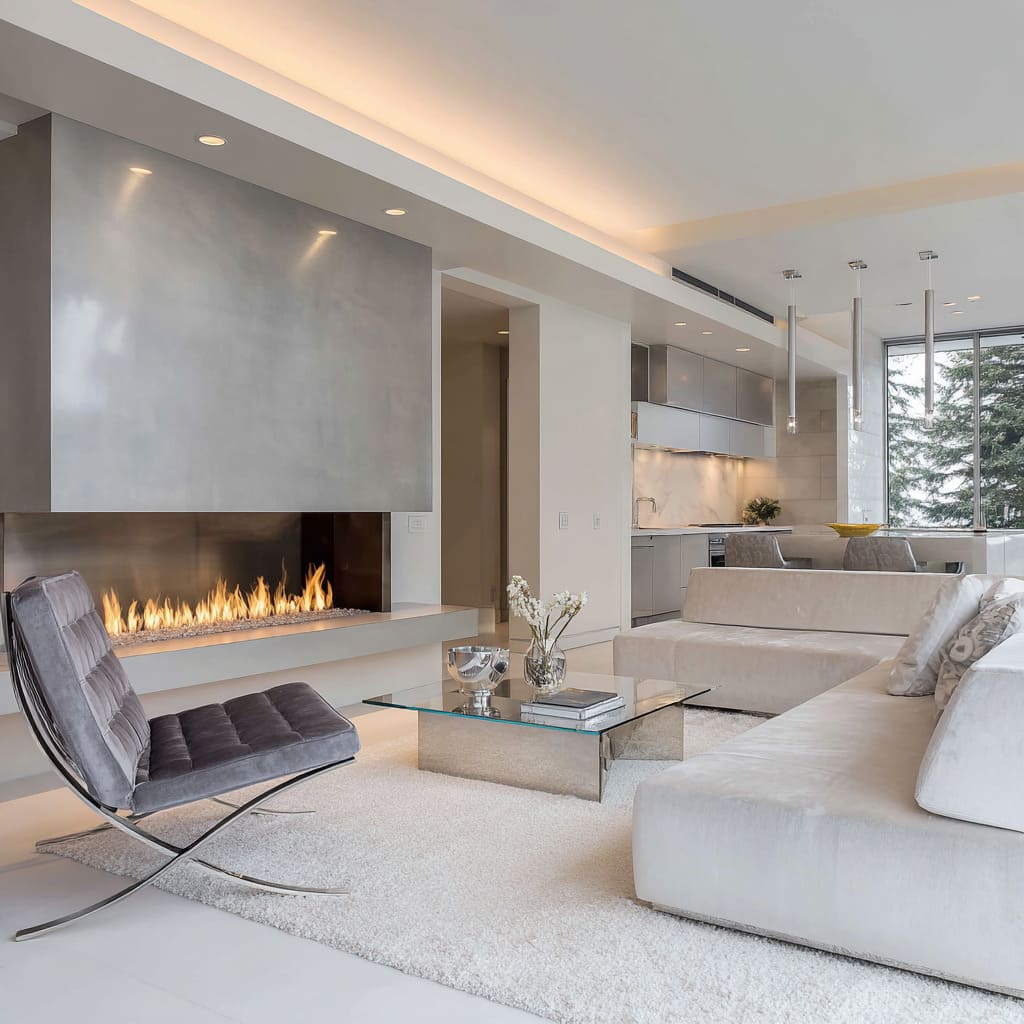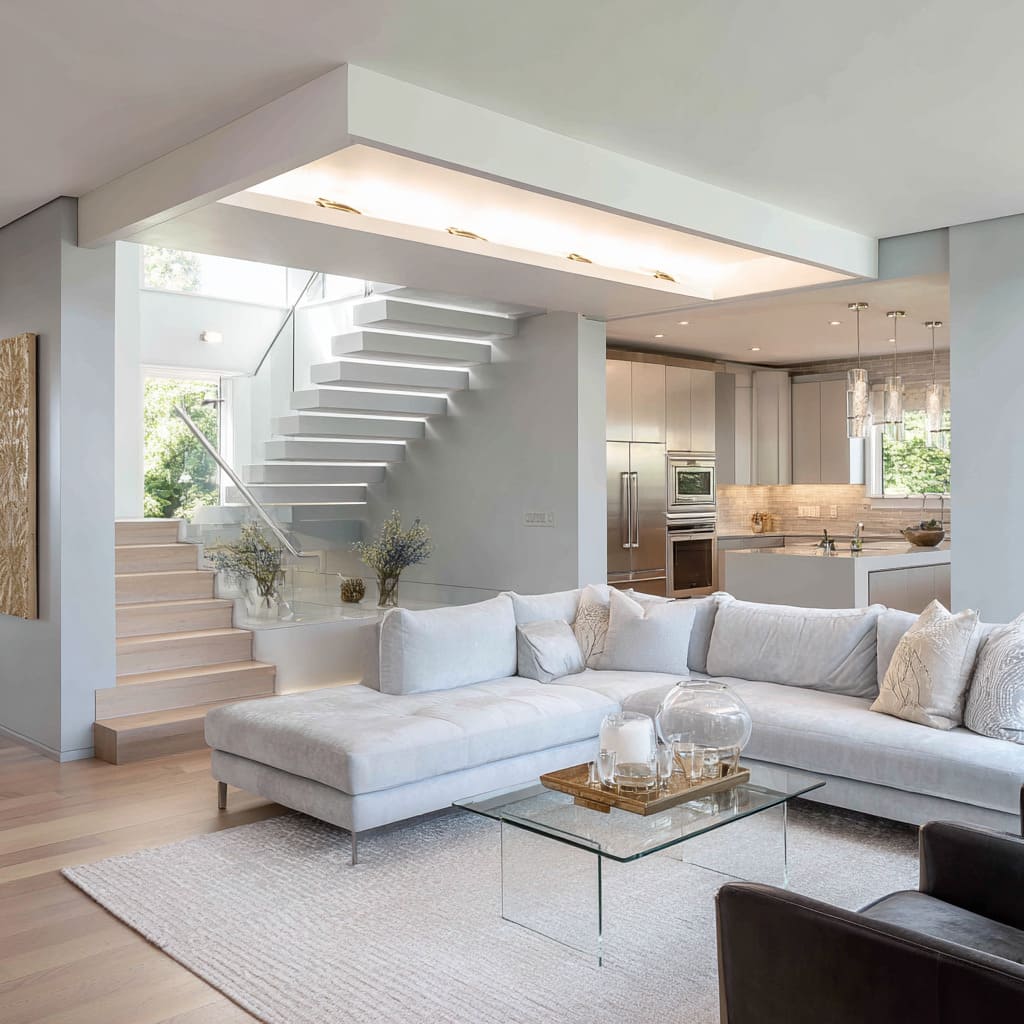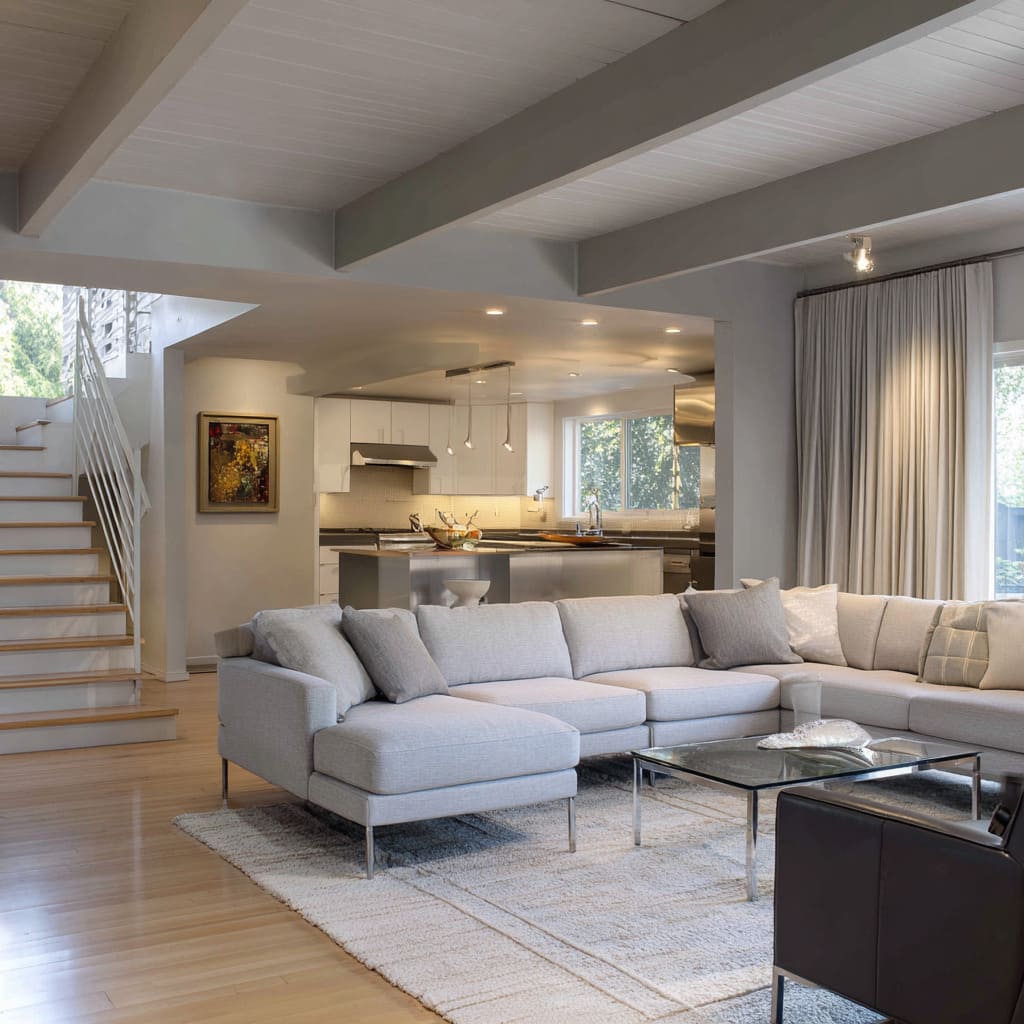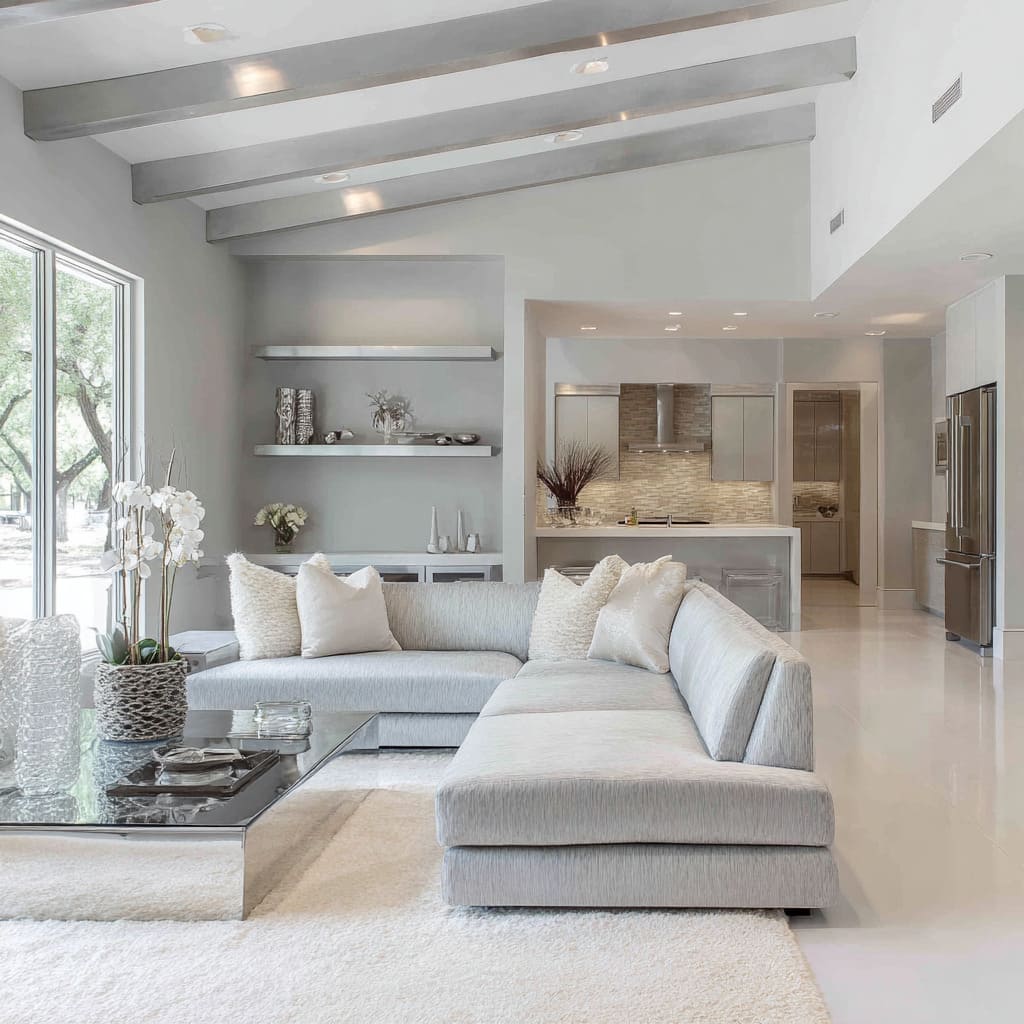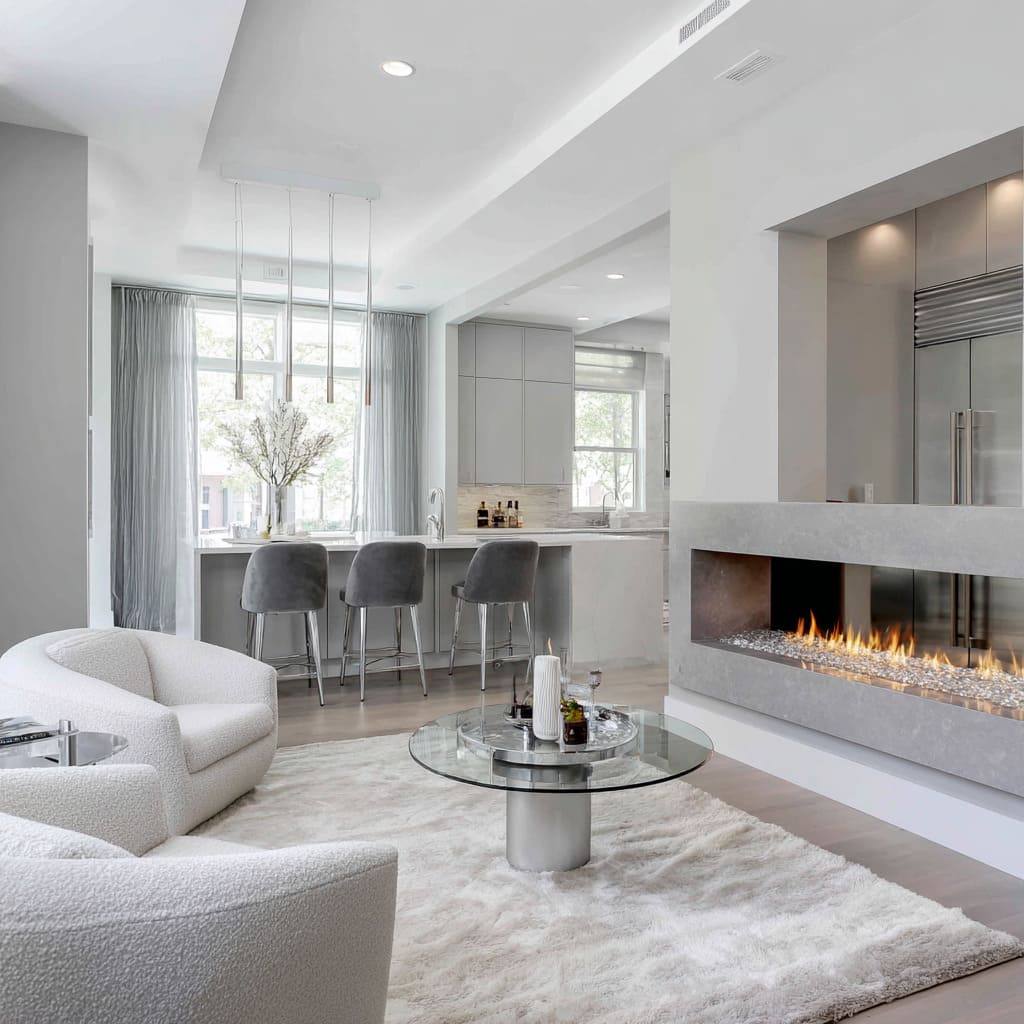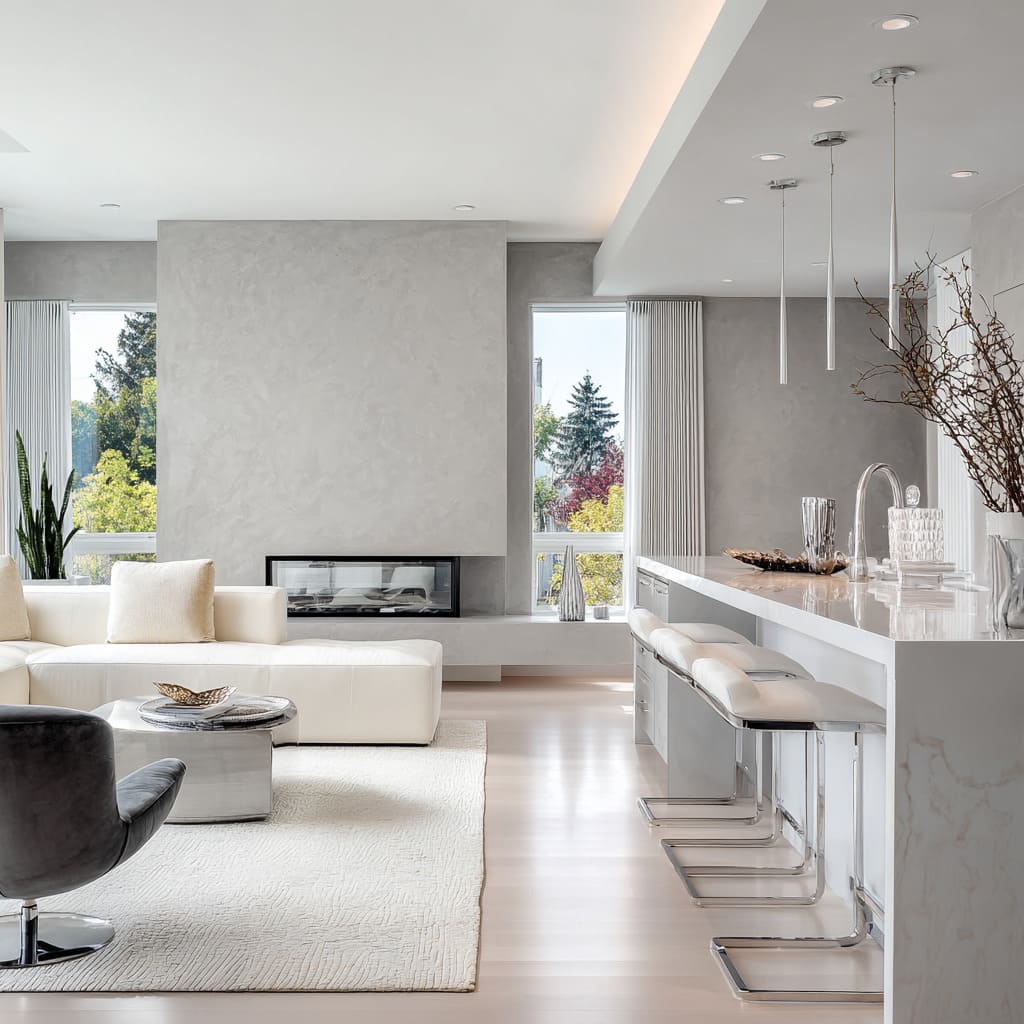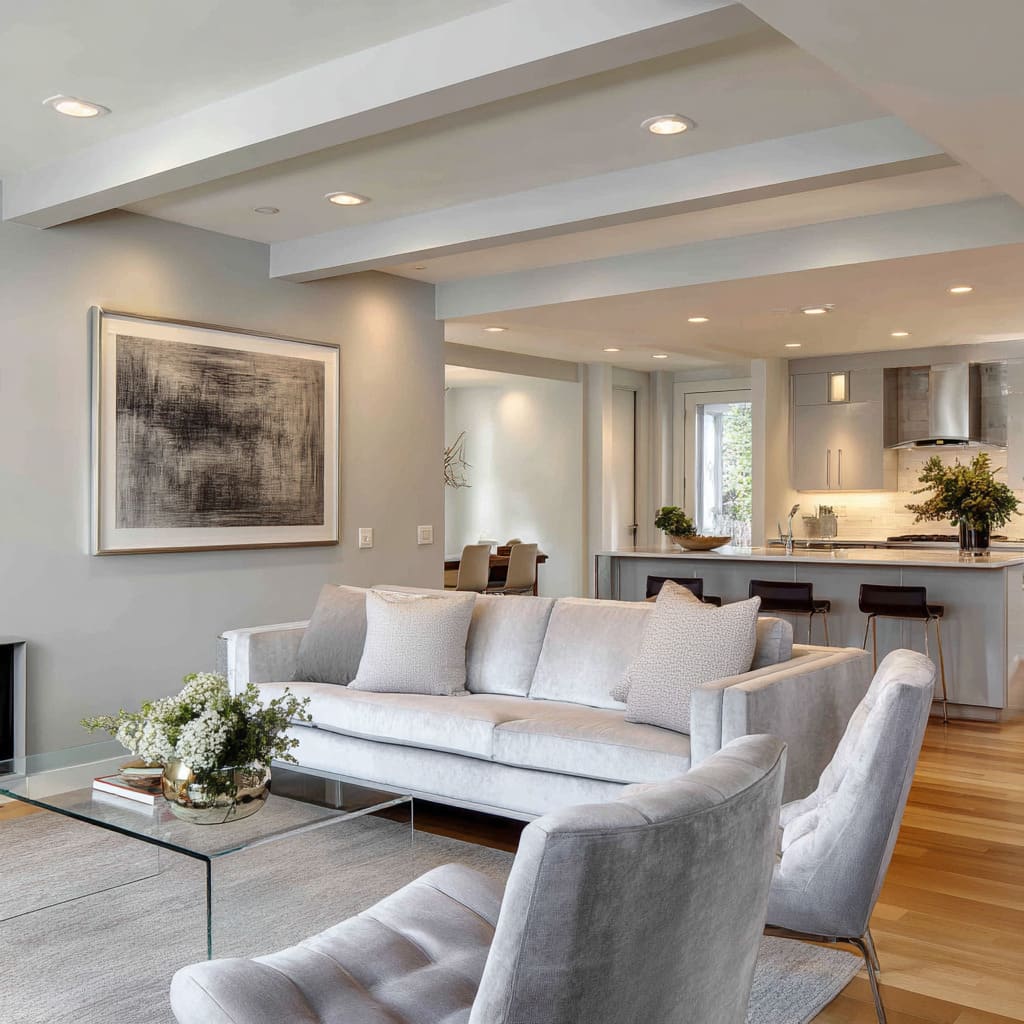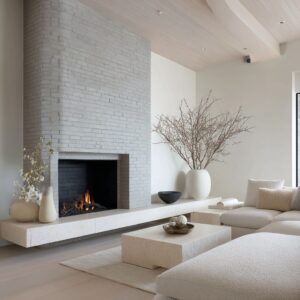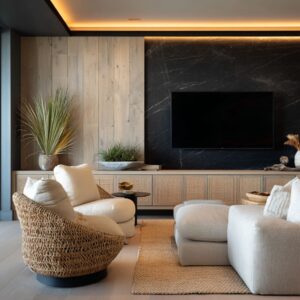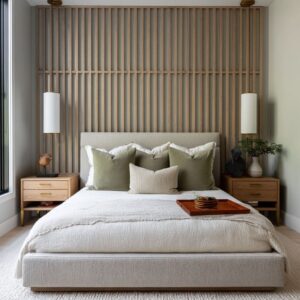Luxury silver living room designs work because silver behaves like editing rather than decoration; the metal sits at edges, touch points, and focal planes while the big volumes stay quiet, which gives the whole scene clarity, brightness, and poise without glare. In rooms that read polished yet serene, the main furniture blocks—sofas, sectionals, large rugs, chimney masses, and expansive wall fields—hold matte, pale textures that drink in light, while silver appears as a refined outline or a controlled mirror where eyes and hands naturally land.
That split between shine and softness is the engine behind luxury silver living room ideas: metal delivers precision and sparkle; textiles and stone deliver rest and depth; together they produce a steady visual rhythm that feels expensive without shouting.
The Balance Between Matte and Metal
A consistent hierarchy gives these interiors their unmistakable calm. Large surfaces in linen, bouclé, chenille, or finely grained stone absorb daylight and blur harsh highlights, then slender metal lines—table frames, chair bases, pendant rods, hardware rims—trace silhouettes and junctions with a fine, bright stroke.
One polished element typically holds the lead, such as a mirror-finish drum table, a mirrored cube, a pair of lacquered coffee tables, a brushed-metal hood, or a mirrored wall behind the island; everything else steps down to brushed or satin finishes that glow rather than flash. This single lead actor avoids visual competition and makes every other reflective note feel intentional; the hero lives at hand or eye height, not high on the wall, so the sparkle stays grounded and human-scaled.
Silver in these spaces behaves like spatial grammar. Vertical anchors—brushed-steel panels, broad metal hoods, mirror planes aligned with pendants—act as spines that knit kitchen and lounge into one statement, while horizontal bands—linear fireplaces, toe-kick glows, island edges, mirrored coffee table faces—behave like horizons that settle the composition.
A subtle, continuous metallic path often runs through the plan: stair handrail to hood to appliance band to sofa legs to coffee table frame. That path is rarely obvious to a casual visitor, yet it’s the reason the room feels coherent; the eye walks a steady circuit, gathering small silver cues at each step and never stumbling into a cluster of disconnected shine.
Reflection is treated as a material in its own right, edited with the same discipline as fabric or stone. Polished surfaces are positioned to capture beautiful content—greenery through glass, flame ribbons, pendant sparkle, soft pleats of drapery—while distracting content stays outside the mirror’s field of view.
Thick rugs, velvet upholstery, and matte stone sit near the hero reflective piece so stray highlights dissolve into a soft halo rather than a sharp blast; sometimes a design pairs two tempos of shine in one object, like a glass top throwing crisp reflections and a darker brushed shelf below offering a blurred echo. That layered tempo of light reads cultured and composed, the visual equivalent of a piece of music with both bright notes and low resonance.
Curves That Calm: The Role of Circular Silver Forms
Curves tame the geometry. Rounded swivel chairs, drum tables, orb pendants, circular mirrors, bowl-seat stools, and ceiling trays with softened corners are placed precisely where the architecture stacks up in straight lines: window grids, long islands, linear fireboxes, and cabinet runs.
A curved silver form reads fluid instead of icy; it calms a strict grid, softens a hard corner, and lets the metal feel like sculpture rather than equipment. This balance—one family of curved silver forms set against ordered rectangles—keeps luxury silver living room ideas from drifting into a laboratory vibe; the result is poised, welcoming, and visually supple.
Gentle Glows Instead of Harsh Beams
Light is handled with quiet restraint so metals glow rather than glare. Narrow fire slots create luminous bars that steady the eye; cove lighting rounds ceiling edges so large planes never feel heavy; under-bench and under-cabinet glows lend floating effects to masses that might otherwise look blocky.
Linear chandelier bars, fine pendant rods, and small crystal or glass points add precision and micro-sparkle instead of broad dazzle, which lets silver read as depth and contour rather than a mirror ball. The most balanced scenes pair one strong reflective plane with a handful of tiny highlights and a background of indirect light that grazes stone, drapery ribs, or brushed steel.
Tonal Discipline: The Calm Spectrum of Silver Interiors
Tonal discipline sets the mood. These rooms stay within a calm spectrum—ivory, soft greys, pale stone, a hint of charcoal—with metals kept consistent in temperature (chrome and stainless together, or warm nickel and champagne together).
Wood tones, basket weaves, and warm metallic frames act as bridges that connect cool silver to warmer flooring or daylight; plants are chosen for silhouette rather than color blast, often topiary spheres, orchids, or round hydrangea heads that give shape without noise. Artwork leans atmospheric: horizontal mist, silver-leaf haze, or fine radial graphics that echo a pendant filament or a centerpiece geometry, keeping movement low and steady rather than busy.
Composition Patterns: How Silver Connects Everyday Layouts
The layouts themselves carry repeatable patterns that make a standard room read curated. Dual rectangles—dining rug and lounge rug—align along a shared window axis, with silver accents spaced evenly so sparkle doesn’t cluster; S-curve sequences lead the eye from lounge chair to sofa to island seating, stepping through intensities of silver from velvet-matte to brushed to polished; floating masses—sofas on slim chrome legs, hearth benches that appear lifted, glass tables with open supports—use narrow metal lines to underline the gap between objects and floor, which makes heavy pieces feel weightless and unmistakably high-end.
Even the quietest detail, like a consistent thin rim around vessels or a precise trim at the fire slot, contributes to that sense of order.
A helpful way to read how these luxury silver living room designs hold together is to separate the scene into role-based layers:.
- Body layer (matte, light-absorbing): sofa blocks, sectional arms, large rugs, chimney volumes, broad cabinet fields, stone waterfalls.
- Edge layer (slim, precise, bright): chair bases, table frames, pendant rods, fire trims, slim hardware rims, sofa legs.
- Hero layer (one focal mirror or brushed plane): mirror drum, mirror cube, lacquered twin tables, brushed-metal hood or panel, mirrored wall.
- Glow layer (soft, directional, horizontal): linear fireplace ribbon, cove halo, toe-kick graze, under-cabinet line, a simple linear chandelier bar.
Kept in this order—body first, edges second, hero third, glow throughout—the composition reads calm and expensive even in a modest envelope. Shift the order, and the room starts to feel noisy or flat; keep it, and the eye experiences steady depth and clarity.
The small-scale objects mirror this discipline. Trays with fine chrome rims, ribbed metal vases, stacked brushed bowls, and clear glass cylinders appear at controlled heights so reflections break neatly without pooling; coffee tables in glass or mirror keep the center light and airy, especially when paired with shag or bouclé underfoot; books and small sculptures step heights subtly rather than building towers, which keeps sparkle in a tidy register.
Sheer drapery with vertical ribs filters daylight into a cool wash that flatters silver, while fuller off-white panels in tall stacks create a soft wall that turns the outside view into a pale, moving backdrop for every metal edge inside.
A few organizing lists make the logic crisp without breaking the flow:.
Silver placement that reads refined rather than flashy
- Coffee table faces or tops that capture garden, fire, or drapery—never clutter.
- Thin linear trims at fireplaces and island edges to set steady horizons
- Chair and stool bases at foot height, spreading micro-highlights through the plan.
- One mirrored or brushed hero surface at mid-level; everything else steps down to satin.
Texture ladder that keeps shine in control
- Matte stone or plaster at the largest fields → bouclé and linen at seating → velvet accents at pillows or chairs → brushed metal at edges → polished metal or mirror at the single focal piece.
Lighting that flatters silver
- Linear fire and cove haloes for broad, soft wash.
- Under-bench or toe-kick glow to float heavy forms.
- A simple linear chandelier or fine pendants for crisp punctuation, not floodlight.
The Luxury of Restraint
What never appears is just as telling: no jumble of mixed metal temperatures, no wall-dominant mirrors in the seating zone, no agitated color on reflective bases, no oversized chrome chandeliers fighting with polished coffee tables, no scatter of shiny gadgets on surfaces meant to read as calm lenses. By removing noise, the remaining silver lines feel deliberate, which is exactly why luxury silver living room ideas register as high-grade rather than trend-chasing.
Open Plans and the Logic of Continuity
In dining-adjacent layouts, an interesting inversion often appears: a thick matte table becomes the anchor while the sparkle travels as a measured path—crystal bar above, chrome chair bases below, a mirrored credenza at the perimeter, and a round silver mirror closing the loop. The glints stay horizontal, level with the muntins or crown, so the eye follows a smooth band through the space instead of hopping vertically in a jittery way.
Velvet benches or channel-back chairs bring depth without darkness, their pile breaking light into a gentle gradient that reads plush and composed.
Open plans show another recurring move: a mid-height silver band linking zones. Satin backsplashes, brushed hoods, and appliance faces line up with stair rails, then continue as sofa legs and table frames; overhead, beam caps with a quiet metal wrap catch a thin highlight that marches toward the kitchen, echoing the mirrored coffee table at center.
In the quietest examples, even the art respects this cadence—horizontal striations or silver-leaf haze that hum with the same tempo as the fire ribbon and island edge.
